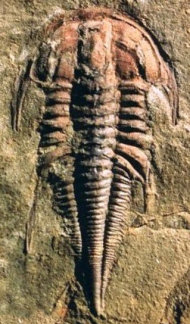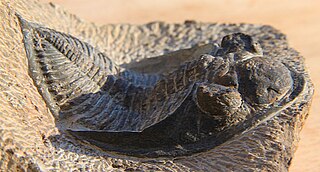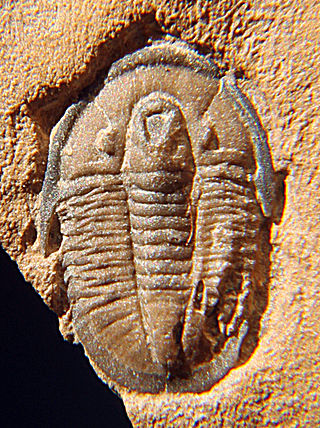
Phacopidae is a family of phacopid trilobites that ranges from the Lower Ordovician to the Upper Devonian, with representatives in all paleocontinents.

Paradoxides is a genus of large to very large trilobite found throughout the world during the Middle Cambrian period. One record-breaking specimen of Paradoxides davidis, described by John William Salter in 1863, is 37 cm (15 in). The cephalon was semicircular with free cheeks ending in long, narrow, recurved spines. Eyes were crescent shaped providing an almost 360° view, but only in the horizontal plane. Its elongate thorax was composed of 19–21 segments and adorned with longish, recurved pleural spines. Its pygidium was comparatively small. Paradoxides is a characteristic Middle-Cambrian trilobite of the 'Atlantic' (Avalonian) fauna. Avalonian rocks were deposited near a small continent called Avalonia in the Paleozoic Iapetus Ocean. Avalonian beds are now in a narrow strip along the East Coast of North America, and in Europe.

Emuellidae are a small family of trilobites, a group of extinct marine arthropods, that lived during the late Lower Cambrian of the East Gondwana supercontinent, in what are today South-Australia and Antarctica.

Huntoniatonia is genus of trilobites, an extinct group of marine arthropods of average to large size.

Dikelocephalus is a genus of very large trilobites of up to 50 cm (20 in) long, that lived during the last 3 million years of the Cambrian (Sunwaptan). Their fossils are commonly found as disarticulated sclerites, in the upper Mississippi Valley and in Canada (Alberta). The exoskeleton is rounded anteriorly, with the thorax and sides of the tailshield slightly tapering to about 2⁄3× of the width across the base of the spines at the back of the headshield. At the side corners of the pygidium there may be triangular or hooked spines, pointing backwards, while between the spines the posterior margin is at a 30-75° angle with the lateral margin, gently convex or nearly straight. If pygidial spines are lacking, the margin is gradually rounded. The thorax has 12 segments.

Dicerodiscus is an extinct genus from a well-known class of fossil marine arthropods, the trilobites. It lived during the early part of the Botomian stage, in China. Four species have been assigned to it. Dicerodiscus is unique for an eodiscoid in having conspicuous and curved spines that are attached anteriorly, and at their base are directed outward perpendicular to the midline, before gradually bending further backwards.

Resserops is an extinct genus from a well-known class of fossil marine arthropods, the trilobites. It lived during the middle of the Atdabanian or the early part of the Botomian stage, which lasted from approximately 524 to 518.5 million years ago. This faunal stage was part of the Cambrian Period. It has been found in Spain and southern Morocco. It can be recognised by the sabre-like spines of the headshield that are a smooth continuation of the frontal edge, and the enlarged spines on the 9th segment of the thorax.

Meteoraspis is an extinct genus of ptychopariid trilobites of the family Tricrepicephalidae. The various species lived from 501 to 497 million years ago during the Dresbachian faunal stage of the late Cambrian Period. Fossils of Meteoraspis are characteristic of Late Cambrian strata in North America, though they are found in Late Cambrian strata elsewhere in the world, such as M. nevensis from Victoria Land, Antarctica.

Alokistocaridae is a family of ptychopariid trilobites that lived from the Botomian epoch of the Early Cambrian until the Late Cambrian. Alokistocarids were particle feeders and left small furrows which are occasionally preserved. Their remains are found worldwide. Elrathia kingii, one of the most collected trilobites in the world, is a typical alokistocarid.
Lotagnostus is a genus of very small trilobites in the order Agnostida, which lived on the outer continental shelves worldwide, during the late Upper Cambrian. It was described by Whitehouse in 1936, and the type species is Lotagnostus trisectus, which was originally described as a species of Agnostus by Salter in 1864.

Phalagnostus is a genus of small trilobites, in the order Agnostida. It lived during the Middle Cambrian, in what are now Canada, China, the Czech Republic, Denmark, England, France, the Russian Federation, Wales, Sweden, and possibly the United States (Vermont). The headshield is almost entirely effaced and wider than the tailshield. The pygidium is also very effaced, but the ovate pygidial axis is well defined and a border furrow is also present.

Odontochile is a genus of trilobites in the order Phacopida, family Dalmanitidae.

Morocconus is an extinct genus from a well-known class of fossil marine arthropods, the trilobites. It is still debated if it lived at the very end of the Lower Cambrian or at the very beginning of the Middle Cambrian. Morocconus notabilis is the only known species in this genus.

Toragnostus is a genus of trilobites restricted to the late Middle Cambrian. Its remains have been found in the United States, Greenland, Denmark, China, Sweden, the Russian Federation, and Kazakhstan. Its headshield and tailshield are almost completely effaced and it has two thorax segments.

Eodiscidae is a family of agnostid trilobites that lived during the final Lower Cambrian and the Middle Cambrian. They are small or very small, and have a thorax of two or three segments. Eodiscidae includes nine genera.

Psychopyge is a genus of trilobite, that lived during the upper Emsian and has been found in Germany and Morocco. It is characterized by the swordlike extension from the front of the head.

Cedaria is an extinct genus of trilobites from the late Cambrian.

Kendallina is a genus of parabolinoidid trilobite with an inverted egg-shaped outline, a wide headshield, small eyes, small deflected spines, 12 thorax segments and a small, short tailshield. It lived during the Late Cambrian in what are today Canada and the United States.

Orygmaspis is a genus of asaphid trilobite with an inverted egg-shaped outline, a wide headshield, small eyes, long genal spines, 12 spined thorax segments and a small, short tailshield, with four pairs of spines. It lived during the Late Cambrian in what are today Canada and the United States.

Genevievella is a genus of trilobites with a short inverted egg-shaped outline, a wide headshield, small eyes, and long genal spines. The backrim of the headshield is inflated and overhangs the first of the 9 thorax segments. The 8th thorax segment from the front bears a backward directed spine that reaches beyond the back end of the exoskeleton. It has an almost oval tailshield with 5 pairs of pleural furrows. It lived during the Upper Cambrian in what are today Canada and the United States.



















